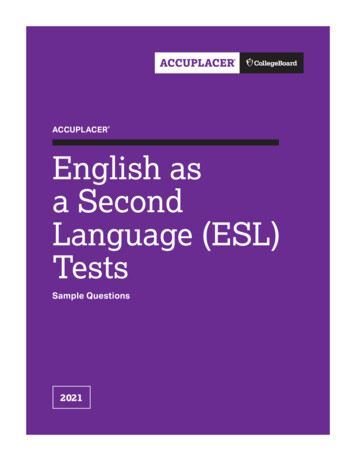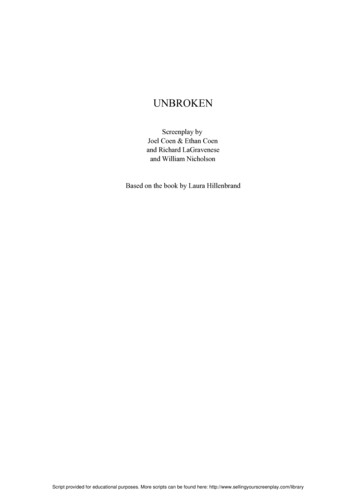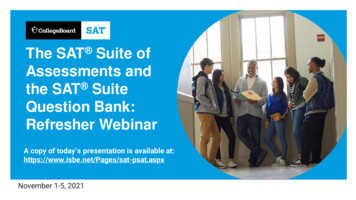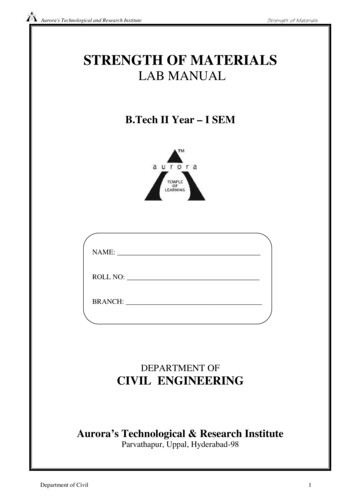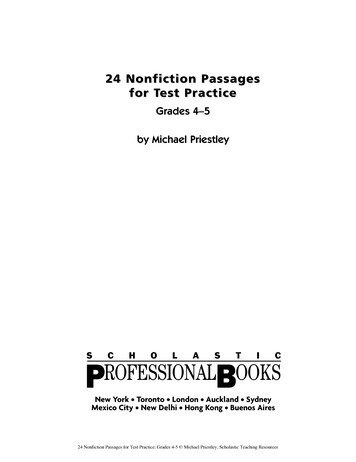
Transcription
24 Nonfiction Passagesfor Test PracticeGrades 4–5by Michael PriestleyNew York Toronto London Auckland SydneyMexico City New Delhi Hong Kong Buenos Aires24 Nonfiction Passages for Test Practice: Grades 4-5 Michael Priestley, Scholastic Teaching Resources
Scholastic Inc. grants teachers permission to photocopy the designated reproducible pagesfrom this book for classroom use. No other part of this publication may be reproduced inwhole or in part, or stored in a retrieval system, or transmitted in any form or by any means,electronic, mechanical, photocopying, recording, or otherwise, without written permission ofthe publisher. For information regarding permission, write to Scholastic Inc., 555 Broadway,New York, NY 10012.Cover design by SolásInterior design by Creative Pages, Inc.Interior illustrations by Kate Flanagan, page 6; Greg Harris, pages 10, 20, 40;Neil Riley, page 40Interior photos by Chris Cole/Duomo/Corbis, page 5; Hulton Archive, pages 6, 16, 36;Duomo/Corbis, page 24; Stock Montage, Inc., Chicago, page 44ISBN 0-439-25609-7Copyright 2002 by Michael Priestley. All rights reserved.Printed in the U.S.A.24 Nonfiction Passages for Test Practice: Grades 4-5 Michael Priestley, Scholastic Teaching Resources
24 Nonfiction Passages for Test PracticeGrades 4–5" Contents #Introduction . . . . . . . . . . . . . . . . . . . . . . . . . . . . . . . . . . . . . . . . . . . . . . . . . . .41.2.3.4.5.6.7.8.9.10.1 1.12.13.14.15.16.17.18.19.20.2 1.22.23.24.Biography: A Soccer Superstar . . . . . . . . . . . . . . . . . . . . . . . . . . . . . . . . .5Informational article: Where Did We Get That Word? . . . . . . . . . . . . . . . . .6Letter to Mr. Peralta . . . . . . . . . . . . . . . . . . . . . . . . . . . . . . . . . . . . . . . .8How-to guide: Secret Messages . . . . . . . . . . . . . . . . . . . . . . . . . . . . . . . .9News story: The Amistad Sails Again . . . . . . . . . . . . . . . . . . . . . . . . . . . .10Announcement: Get Ready for the Talent Show . . . . . . . . . . . . . . . . . . . .12Informational article: Fighting Fires . . . . . . . . . . . . . . . . . . . . . . . . . . . .13Essay: On Being Yourself . . . . . . . . . . . . . . . . . . . . . . . . . . . . . . . . . . . .14Biography: Sequoyah . . . . . . . . . . . . . . . . . . . . . . . . . . . . . . . . . . . . . .16Review: The World of Harry Potter . . . . . . . . . . . . . . . . . . . . . . . . . . . . .18Franny’s Journal . . . . . . . . . . . . . . . . . . . . . . . . . . . . . . . . . . . . . . . . . .19Informational article: A Park in Danger . . . . . . . . . . . . . . . . . . . . . . . . . .20How-to guide: How to Make a Swan . . . . . . . . . . . . . . . . . . . . . . . . . . . .22Biography: A Hero for the World . . . . . . . . . . . . . . . . . . . . . . . . . . . . . .24Comparison/Contrast: Whales and Dolphins . . . . . . . . . . . . . . . . . . . . . .26A Letter from Washington, D.C. . . . . . . . . . . . . . . . . . . . . . . . . . . . . . . .28A Kid Pages Interview . . . . . . . . . . . . . . . . . . . . . . . . . . . . . . . . . . . . . .30Editorial: School Uniforms? Think Again! . . . . . . . . . . . . . . . . . . . . . . . .32Textbook article: Kingdoms of Gold: The Empires of West Africa . . . . . . . .34Speech: “I Will Fight No More Forever” . . . . . . . . . . . . . . . . . . . . . . . . .36Advertisement: Crockett Travel Agency . . . . . . . . . . . . . . . . . . . . . . . . . .38Informational article: Beekeeping Basics . . . . . . . . . . . . . . . . . . . . . . . . .40Autobiography: How I Came to the Museum . . . . . . . . . . . . . . . . . . . . . .42Comparison/Contrast: Bridging the Gaps in New York City . . . . . . . . . . . . .44Answer Key . . . . . . . . . . . . . . . . . . . . . . . . . . . . . . . . . . . . . . . . . . . . . . . . . .46!24 Nonfiction Passages for Test Practice: Grades 4-5 Michael Priestley, Scholastic Teaching Resources
Intr oduction to TeachersToday’s students receive information from an ever-increasing number of sources. To managethis overload of information, students must be able to distinguish between what is importantand what is not—a key skill in reading nonfiction. They must understand what they read intraditional forms of nonfiction, such as textbooks and news articles, but they must alsocomprehend newer forms of nonfiction, such as advertisements on Web sites and e-mail on theInternet. Many students can benefit from reading more nonfiction, but finding good examplesof nonfiction for instruction at different grade levels can be challenging.How to Use This BookThe purpose of this book is to provide interesting, well-written nonfiction selections forstudents to read. These selections can be used for practice and instruction in reading nonfiction,and they can be used to help prepare students for taking tests that include nonfiction passages.This book provides 24 grade-appropriate nonfiction texts in a wide variety of genres, frominformational articles, letters, and biographies to e-mail announcements and how-to guides.Each text (of one page or two pages) focuses on a high-interest topic and has: a prereading question to help students focus on what they read.a set of 2–6 comprehension questions that resemble the kinds of questions students willsee on standardized tests.The questions with these texts are designed to measure critical thinking and comprehensionskills, such as summarizing information, drawing conclusions, and evaluating an author’s purposeand point of view. These questions will help you assess students’ comprehension of the materialand will help students practice answering test questions. For different passages, questions includemultiple-choice items, short-answer items, and written-response items that require longeranswers. (You will find answers to these questions in the Answer Key beginning on page 46.)Extending ActivitiesFor some of these richly detailed texts, you may want to have students go beyond answeringonly the questions that are provided. For example, for any given text you could have studentswrite a summary of the selection in their own words or rewrite the passage from a differentpoint of view. For some pairs of texts, you might have students compare and contrast the twoselections. For other texts, you might want to create writing prompts and have students writefull-length essays about what they have learned. Students will benefit from reading andanalyzing these texts, discussing them in class or in small groups, and writing about them ina variety of ways.424 Nonfiction Passages for Test Practice: Grades 4-5 Michael Priestley, Scholastic Teaching Resources
NameTe x t 1DateWho is Brandi Chastain?he United States and China weretied 4–4 in the final game of theWomen’s World Cup soccer match.More than 90,000 fans packed the RoseBowl in California, where the game wasbeing played. Another forty millionpeople were watching on TV. All eyeswere on Brandi Chastain, who wasabout to take her turn in the penaltykick shoot-out that would decide thewinner. The ball flew into the upperright corner of the net. She had scored agoal! The U.S. team won 5–4!Making that final goal to win the 1999World Cup may well have been thehighlight of Chastain’s career as a soccerplayer. But it was not her only triumph.She had been a soccer star in high schooland college. She played on a winningWorld Cup team in 1991. At the 1996Olympic games, when the U.S. women’steam won the gold medal, Chastainplayed every minute of every game.Soccer was at the center of her life.Unfortunately, there were nowomen’s professional teams in theUnited States for this talented athlete tojoin. In 1993, Chastain played for oneseason on a professional team in Japan.She was voted the team’s most valuableplayer. But when she returned home,she could not continue playing socceras a professional.Then at last, in May 2000, a UnitedStates professional league for women wasformed. The Women’s United SoccerAssociation (WUSA) set up eight teams.Women from the 1999 World Cup teamwere assigned to differentteams in the new league.Brandi Chastain wasassigned to play forSan Francisco.Would she mindplaying against herformer teammates?Not likely! As usual,Brandi Chastainwelcomed thechance to play againsttough opponents—and win.1.When Brandi Chastain made the most famous goal of hercareer, she was playing against —A China.C Japan.B her former teammates.D San Francisco.2.What can you tell about the 1999 U.S. World Cup team fromthis article?F Members of the team had been playing together for many years.G Everyone expected the team to win.H The players were not professionals.J It was the first U.S. team to win the Women’s World Cup.24 Nonfiction Passages for Test Practice: Grades 4-5 Michael Priestley, Scholastic Teaching Resources5
NameTe x t 2DateWhy is a sandwich called aThe dancer put a cardigan sweater over her leotard. Then she sat down toeat a sandwich. Cardigan, leotard, sandwich—where did these words comefrom? Did you know that each of them was a person’s name? Words thatcome from proper names are called eponyms, and there aremany eponyms in English.The sandwich, for example, was named for JohnMontagu, the Earl of Sandwich. He lived from1718–1792. He loved to play cards and did not want tostop a game even to eat. By putting cold meat betweentwo pieces of bread, he could eat while he played.The cardigan sweater was named for an officer in theBritish army. In the 1800s, James Thomas Brudenell, the Earl of Cardigan,spent his own money to buy special knitted jackets for the men in hisregiment. Knitted jackets with buttons soon came to be called cardigans.Jules Leotard was a French circus performer. In 1859,at the age of twenty-one, Leotard performed the firstmid-air somersault. He became known as the “daringyoung man on the flying trapeze.” Leotard inventeda close-fitting one-piece suit to wear when heperformed. Dancers and acrobats still call theirclose-fitting garments leotards.Another person who gave her name to a styleof clothing was Amelia Bloomer. Bloomer wasthe editor of a magazine called The Lily.American women in her day were expected towear heavy skirts that dragged on the floor. In1851, a young woman named Elizabeth SmithMiller introduced a new kind of clothing thatwas much easier to move around in. She worea dress that came only to the knees. Under itshe wore baggy pants that fitted close at theankles. Amelia Bloomer published a pictureof the outfit in The Lily. She hoped womenwould adopt the new style. In news stories,reporters called the pants “bloomers.”A hundred years later, people were stillusing the word bloomers for pants wornunder a dress.624 Nonfiction Passages for Test Practice: Grades 4-5 Michael Priestley, Scholastic Teaching Resources
There are many other words that come from people’s names. Thediesel engine was named for its inventor, Rudolf Diesel. The wordboycott comes from the name of an English landlord named CharlesBoycott. Where each word came from is a story in itself. Who knows,maybe your name will become a word someday.1.Which of these word stories would best fit in this article?A Armadillo comes from a Spanish word meaning “armed.”The animal’s hard shell looks like armor.B Braille is a system of writing for the blind that wasdeveloped by Louis Braille.C Cricket is a word that imitates the sound a cricket makes.D Dynamite comes from a Greek word meaning “power.”Alfred Nobel, the inventor of dynamite, created the word.2.Which of these words came from a person’s name?F trapezeG editorH boycottJ acrobat3.What is this article mainly about?4.Why did the Earl of Sandwich invent the “sandwich”?5.What are “bloomers,” and where did the word bloomerscome from?24 Nonfiction Passages for Test Practice: Grades 4-5 Michael Priestley, Scholastic Teaching Resources7
NameTe x t 3DateWhat did Mr. Peralta do?October 9, 2001Mr. Emilio Peralta, WKVP-TV29 Rivera St.Newtonville, NebraskaDear Mr. Peralta:Thank you for speaking to our class last Thursday. It was very exciting tomeet a real television personality! We all learned a lot about how you make yourweather predictions. And it was fun to see some of the equipment you use.After you left, we made a list of what we had learned. Then we set up a smallweather station outside our classroom. From now on, one student in the classwill be the weather person every day. He or she will record weather data in ourweather book. After a few months, we will start making graphs and charts thatshow our weather patterns here in Nebraska. We will use the Internet to shareour information with students all over the United States. Next year’s studentswill continue our work.As you can see, your visit has given us a lot of ideas. Thank you so much foropening our eyes to this interesting subject.Sincerely,B. J. GluckMrs. Morse’s Class, Oakview School81.What is B. J.’s purpose in writing this letter?2.What is Mr. Peralta’s job?3.Why do you think Mrs. Morse invited Mr. Peralta to speak toher class?24 Nonfiction Passages for Test Practice: Grades 4-5 Michael Priestley, Scholastic Teaching Resources
NameTe x t 4DateTIVVGRMTH! Can you guess what that means?ould you and your friends like to write secret messages to each other?If you read this article, you will soon know how to do it.Secret codes have been used throughout history to send messages. A codegives special meanings to symbols, words, or even a nod of the head. Codescan be difficult to learn. Some codes can be used only by people who havethe same code book or computer program.For secret messages that you write to your friends, it is best to use a cipher.Unlike a code, a cipher uses the regular meanings of words. The words lookfunny, though. Each letter has been changed to something else. It might beanother letter, a number, or a symbol. Words written in cipher are easy toread once you know the key. Here is an example.1) Write the alphabet in one row. Under it, write the alphabet backwards.Place each letter directly under a letter in the first row.A B C D E F G H I J K L M N OP Q R S T U V WX Y ZZ Y X WV U T S R Q P O N M L K J I H G F E D C B A2)3)4)To write a message, use the letters in the second row to stand for the lettersyou really mean. For example, the word YOU would be BLF.To read the message, change each letter back. If BLF is in the message,find B in the bottom row. You can see that it stands for Y.People who want to know your secrets might try to figure out the key to yourcipher. To make the cipher harder to figure out, change the spacing of thewords. You can put letters in groups of five: HVXIV GNVHH ZTVHXZMYVU FM. Using the key, it becomes SECRE TMESS AGESCANBEF UN. Put the spaces in the right places. Now it says, “SECRETMESSAGES CAN BE FUN.”1.What does “TIVVGRMTH” mean? Use the cipher you learnedin this article.2.Which is an example of a cipher?A Apple stands for “Call me tonight.” Peach means “Don’t call.”B WAFMAC means “Wait for me at the corner.”C Raising the left thumb means “That’s right.”D 1 stands for A, 2 for B, 3 for C, and so on, so 3-1-2 means “cab.”3.How is a cipher different from a code?24 Nonfiction Passages for Test Practice: Grades 4-5 Michael Priestley, Scholastic Teaching Resources9
NameTe x t 5DateWhy would anyone build a new ship using really old plans?YSTIC, Connecticut—Thousands of people cameto the Mystic Seaportrecently to see the launch of a shipcalled the Amistad. The ship’sbuilders used plans and tools fromthe nineteenth century to re-create awooden sailing ship. The ship tooktwo years to build.The original Amistad becamefamous in 1839. It was sailing to theUnited States from Cuba. On boardwere 53 Africans who had beentaken from Sierra Leone, their homecountry, and shipped to Cuba. InCuba, they had been sold as slaves.It was a crime to bring new slavesinto the United States. The menwho were bringing Africans to theUnited States on the Amistad didn’tcare about the law. They had brokenit before. But this time they were infor a terrible surprise. The Africanson the ship rebelled. They killed thecaptain and took over the ship.The Africans wanted tosail back to SierraLeone. The ship’screw fooled theAfricans and10took them to Connecticut instead.There, the Africans were caught, putin jail, and tried for murder. But inthe end, they won their freedom.In 1976, Warren Marr, a magazineeditor, came up with the idea ofrebuilding the Amistad. He thoughtit would be a good way to honor theAmistad story (which was also toldin the 1997 movie Amistad, directedby Steven Spielberg). For more than14 years, Marr worked to interestpeople in the project. In 1990, hecame to the Mystic Seaport. That’swhen the project really took off.The Mystic Seaport helped raiseover three million dollars to buildthe ship.The new Amistad will be both aship and a museum. Its first stopwill be Operation Sail 2000 in NewYork harbor on July 4. Then it willsail on, carrying its storyof the strugglefor freedom.24 Nonfiction Passages for Test Practice: Grades 4-5 Michael Priestley, Scholastic Teaching Resources
1.What is the main idea of this article?A It was a crime to bring new slaves into the United Statesin 1839.B A new Amistad has been launched to help tell theAmistad story.C Warren Marr came up with the idea of rebuildingthe Amistad.D The Africans who rebelled on the Amistad wontheir freedom.2.Why was the Amistad a famous ship?3.In 1839, how did the Africans on the Amistad end upin Connecticut?4.Why do you think both Warren Marr and StevenSpielberg wanted to retell the story of the Amistad?24 Nonfiction Passages for Test Practice: Grades 4-5 Michael Priestley, Scholastic Teaching Resources11
NameDateTe x t 6Would you like to be in a talent show?Get Ready for theTALENT SHOWGet out your guitars! Dust off your drums! This year’s Carey SchoolTalent Show will be held on March 16.To make this year’s show the best ever, we are trying to get asmany different kinds of acts as possible. Singers, tap dancers,storytellers, magicians—whatever your talent may be, you are welcometo sign up. We are also hoping to have more family acts with parents andchildren performing together.Most people seem to agree that last year’s show had too many lip-synch acts. Someof them were too long. This year, we plan to limit the number of lip-synch acts to nomore than six. Each lip-synch group must have at least three people in it. The length ofeach performance should be no more than five minutes. Groupsthat want to do a lip-synch must choose a song and presenttheir idea to the Talent Show Committee by February 25.The Talent Show sign-up sheet is in the school office.Students who want to be in the show should sign up as soonas possible. The last day to sign up is February 23. Mrs.Whittle and Mr. Denby will make the final decision aboutwhich acts will be included in the show.1.12What kind of selection is this?A editorialB reviewCDannouncementletter to the editor2.What was the problem with last year’s Talent Show? Whatchanges are being made to correct the problem?3.If you want to be in the Talent Show, you should —F sign up in the office.G talk to the Talent Show Committee.H tell Mrs. Whittle or Mr. Denby.J get a guitar.24 Nonfiction Passages for Test Practice: Grades 4-5 Michael Priestley, Scholastic Teaching Resources
NameTe x t 7DateWhat is a bucket brigade?othing gets people moving fasterthan the word fire. Whensomeone yells “Fire!” most peopledash for the exits. Their only thoughtis to get out of the building fast.Firefighters, on the other hand, racejust as quickly toward the fire. Theywant to put out the blaze as fast aspossible.There are more than one millionfirefighters in the United States today.They are trained to put out fires.Back in the 1600s, though, therewere no trained firefighters. Puttingout fires was everyone’s job.Cities and towns had noindoor plumbing, runningwater, or fire hydrants, sowater from a pond, river, orwell had to be carried to thefire in buckets. When a firebroke out, everyone ran tohelp. They formed a bucketbrigade. Men formed one line leadingfrom the water supply and passedbuckets of water to throw on the fire.Women and children formed anotherline, sending empty buckets back tobe filled. It was a very slow way toput out a fire, and many homesburned to the ground before theycould be saved.Then in 1736, Benjamin Franklincame up with the idea for a firedepartment. He convinced a group ofpeople in Philadelphia to form theUnion Fire Company. They becamethe first official volunteer firefighters.Today, three out of four Americanfirefighters are volunteers. Thesebrave men and women do not getpaid for their work, but they are ingood company. George Washington,Thomas Jefferson, and Paul Reverewere all volunteer firefighters,too, in their day.1.People formed “bucket brigades” to —A prevent fires from starting.C rescue people trapped in a fire.B put out fires.D warn other people about a fire.2.How did a bucket brigade work?3.How, when, and where was the first fire company formed?24 Nonfiction Passages for Test Practice: Grades 4-5 Michael Priestley, Scholastic Teaching Resources13
NameTe x t 8DateWhat makes you special?veryone likes to feel that heor she is special.Unfortunately, many of usgrow up believing that we’re notspecial at all. We wish that we couldbe better at sports or more attractive.We wish we had nicer clothes ormore money. Like the Scarecrow,the Tin Man, or the Cowardly Lionfrom The Wizard of Oz, we believewe’re not good enough just as weare. In the movie, the Scarecrowwishes that he had a brain. The TinMan wishes he had a heart, and theLion wants courage. In the end,each of them realizes that he alreadyhas what he needs.Most parents want us to be thebest we can be. They sometimes tryto encourage us to do better bycomparing us to others. They meanwell, but the message we often get isthat we’re not good enough. Webegin to believe that the only waywe can be special is by being better14than someone else, but we are oftendisappointed. There will always besomeone out there who is better thanwe are at something. There areplenty of people around who maynot be as smart as we are but whoare better at sports. Or they may notbe as good-looking, but they havemore money. It is impossible for usto be better than everyone else allthe time.Like the Scarecrow, the Tin Man,and the Cowardly Lion, we all wantwhat we believe will make us betterpeople. What we don’t realize is thatoften we already have inside us thevery things that we seek. Parentssometimes forget to tell us that we arespecial, that we are good enough justas we are. Maybe no one told themwhen they were growing up, ormaybe they just forgot. Either way, it’sup to us to remind them from time totime that each of us, in our own way,is special. What we are . . . is enough.1.This essay was most likely written by a —A young person.B parent.C teacher.D coach.2.The author of this essay believes that —F not everyone can be special.G smart people are more special than others.H the richer you are, the better you are.J we are all good enough just the way we are.24 Nonfiction Passages for Test Practice: Grades 4-5 Michael Priestley, Scholastic Teaching Resources
3.Why does the author believe it is not a good idea tocompare yourself to others in order to feel special?4.Why does the author discuss characters from The Wizardof Oz in this essay? What point is the author trying to make?5.What makes you special? Write a paragraph telling whatyou like about yourself.24 Nonfiction Passages for Test Practice: Grades 4-5 Michael Priestley, Scholastic Teaching Resources15
NameTe x t 9DateWho was Sequoyah?"!#"!magine a man who cannot read orwrite. Now imagine that same mancreating a brand new alphabet fromscratch. It sounds next to impossible,doesn’t it? Yet that is exactly what oneman did—a man named Sequoyah.Born around 1770 in Tennessee,Sequoyah was a Cherokee. Like otherNative Americans of that time, he couldneither read nor write. He couldn’t helpnoticing, though, how white people wroteto one another on sheets of paper. Theyoften used these “talking leaves,” as someNative Americans called them, to communicate.Back then, the Cherokee had no way to write down words in their ownlanguage. Sequoyah believed it was important for the Cherokee to have asystem of writing. So, in 1809, he set out to create an alphabet that theCherokee could use to do just that.Sequoyah started by drawing pictures, with each one representinga different word or idea. He soon realized that writing sentences usingpictures would be much too difficult. There were too many words. Noone would ever be able to remember that many pictures.Sequoyah decided to try a different approach. He began to developsymbols to stand for the sounds, or syllables, that made up words. Twelveyears later, he completed a system of writing with 86 different symbols.Each one stood for a different syllable in the Cherokee language. Thesymbols could easily be put together to form words. Soon thousands ofCherokee were able to read and write in their own language.Sequoyah’s work did not end there, however. He helped to establish aprint shop and began publishing a bilingual newspaper in both Cherokeeand English. The shop also printed books translated from English intoCherokee. In later years, Sequoyah also became a political leaderamong the Cherokee.#####1624 Nonfiction Passages for Test Practice: Grades 4-5 Michael Priestley, Scholastic Teaching Resources
Sequoyah died in 1843, but many Cherokee of today still use thealphabet he invented. Thanks to him, the Cherokee now have awritten history that will never be forgotten. In honor of hisachievements, Sequoyah’s name was given to the giant redwood trees ofCalifornia and the Sequoia National Park. The name of Sequoyahwill never be forgotten either.1.Sequoyah is best remembered for —A not being able to read or write.B being raised as a Cherokee.C drawing pictures to represent words or ideas.D inventing a written language for the Cherokee.2.White people used “talking leaves” to communicate.What were “talking leaves”?"!#3.Which did Sequoyah do just after he completed the set ofsymbols for the Cherokee language?F He drew pictures to represent words and ideas.G He began growing giant redwood trees.H He helped to start a printing press and a newspaper.J He became a political leader.4.Give one reason why Sequoyah’s invention was importantto the Cherokee.5.What did the people of the United States do tohonor Sequoyah?24 Nonfiction Passages for Test Practice: Grades 4-5 Michael Priestley, Scholastic Teaching Resources"!17
NameTe x t 1 0DateWhat is this Harry Potter book about?ow would you like towake up one morningand discover that you’rereally a wizard? That iswhat happens to Harry Potter inHarry Potter and the Sorcerer’s Stone,a novel written by J.K. Rowling.Harry, an orphan, has spent mostof his ten years living with his meanrelatives, the Dursleys. His UncleVernon and Aunt Petunia treat himlike dirt. Their son Dudley is a bigbully who picks on Harry everychance he gets.Harry sleeps in a tiny closet underthe stairs and wishes that someonesomeday would come take himaway. But that hasn’t happened yet.Harry has all but given up hopethat it ever will.A few days before Harry’seleventh birthday, strange lettersbegin arriving. They are addressedto Harry. His aunt and uncle,18though, won’t let him read them—that is, until a giant named Hagriddelivers one in person. That’s whenHarry learns that he is a wizard. Hehas just been accepted as a studentat Hogwarts School of Witchcraftand Wizardry.Just like that, Harry Potter goesfrom being a nobody to being afamous wizard. Who would haveguessed? Not only that, but Harryalso discovers that his parents didn’tdie in a car crash after all. They weredone in by an evil wizard, a wizardso powerful that everyone is afraideven to say his name: Voldemort.Harry Potter and the Sorcerer’sStone is a beautifully writtenfantasy. If you love action,you won’t be disappointed.It is very funny andimaginative, and it willkeep you reading long pastyour bedtime.1.In this book, Harry Potter finds out that he is —A an orphan.B a giant.C an author.D a wizard.2.How does the author of this book review feel about Harry Potterand the Sorcerer’s Stone? How can you tell?24 Nonfiction Passages for Test Practice: Grades 4-5 Michael Priestley, Scholastic Teaching Resources
NameTe x t 1 1DateOn May 17, Franny got quite a scare. Read thispage from her journal to find out what happened.May 17I had the scare of my life today. When I stopped by Mrs. Nolan’s house, she asked if Iwould mind taking her dog Buster out for a walk. Are you kidding? A few minutes later,Buster and I were jogging happily toward the park.We were almost there when this enormous black dog suddenly appeared from out ofnowhere. Before I could react, the giant dog attacked Buster and tried to sink its teeth intoBuster’s neck. I just stood there frozen, unable to move. The next thing I knew, both dogswere rolling around on the ground, snarling and growling and biting each other. It was justawful. I was too scared even to cry out for help.Thank goodness someone showed up just then. A boy about my age grabbed the blackdog’s collar and pulled him off Buster. The black beast was his. He said he was really, reallysorry. His dog had yanked the leash right out of his hand and managed to get away. Itwouldn’t happen again.I was still shaking when I got back to Mrs. Nolan’s house. Poor Buster was limping. Oneear was torn and he was bleeding in several places. Mrs. Nolan took one look at us and gasped.I helped her load Buster into the car, and we drove right over to the animal hospital.Buster was beaten up pretty badly, but the vet says he should be fine in a few days. I’m not sosure about me, though. I still feel it was my fault that Buster got hurt. Mrs. Nolan says, no, no,of course not, there was nothing I could do. But her kind words didn’t make me feel any better.1.On
a set of 2–6 comprehension questions that resemble the kinds of questions students will see on standardized tests. The questions with these texts are designed to measure critical thinking and comprehension skills, such as summarizing information, drawing conclusio
